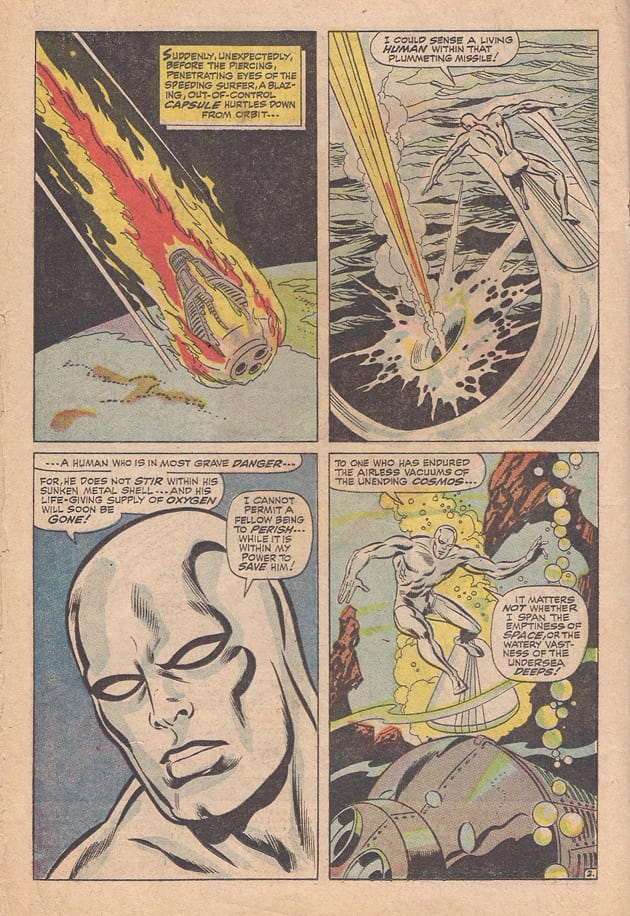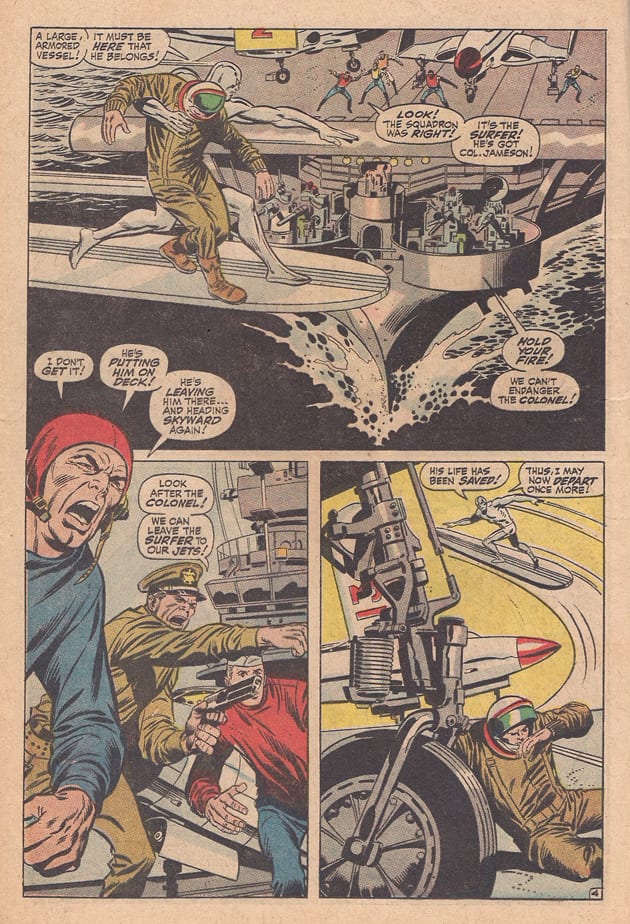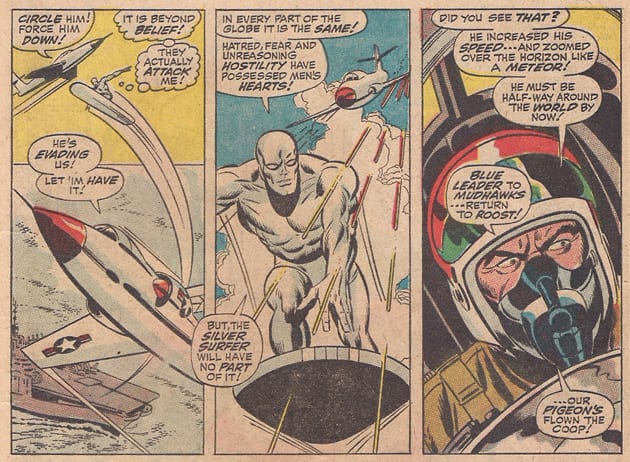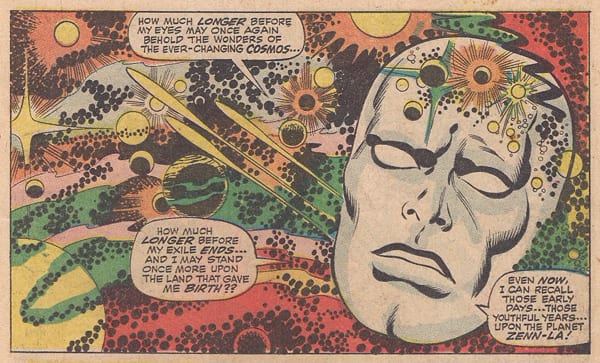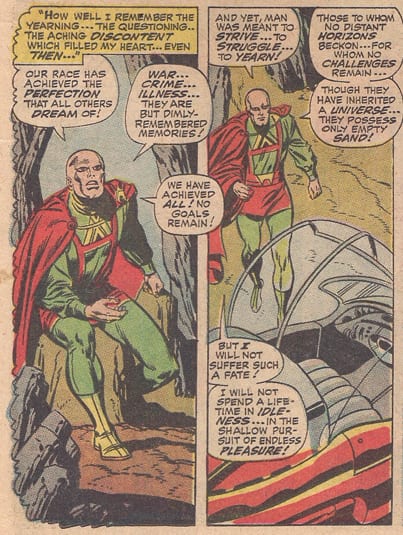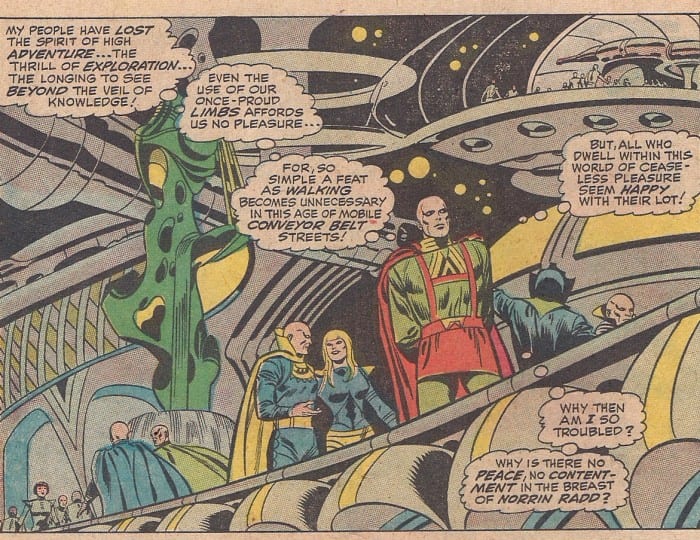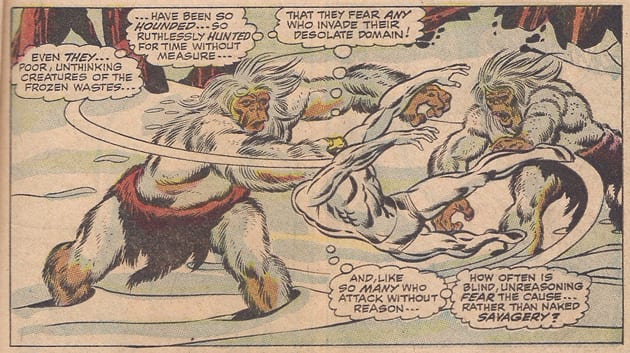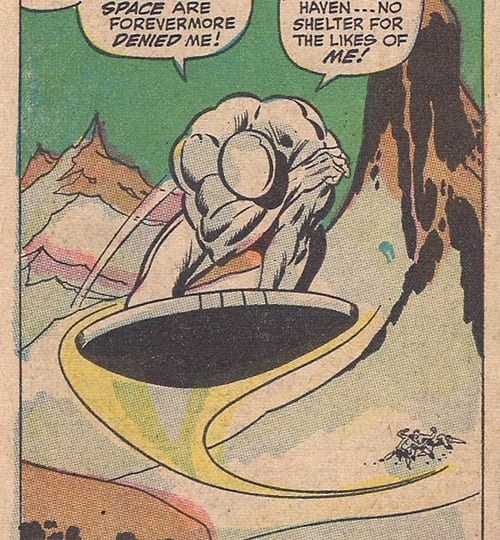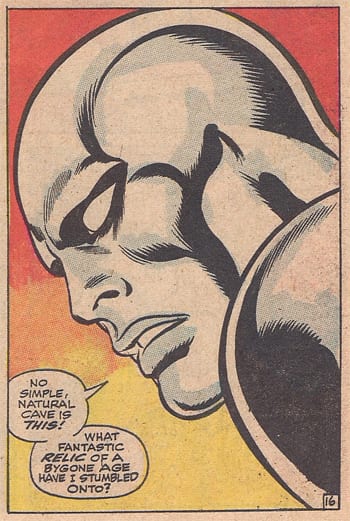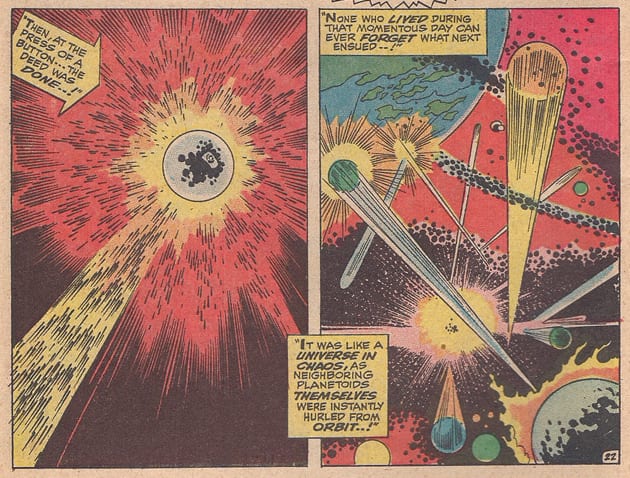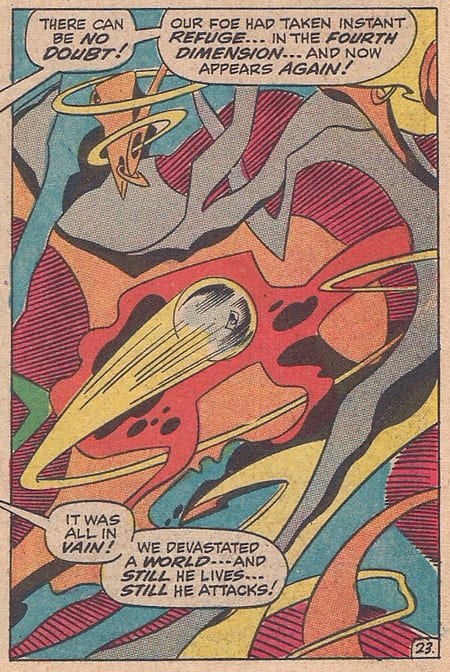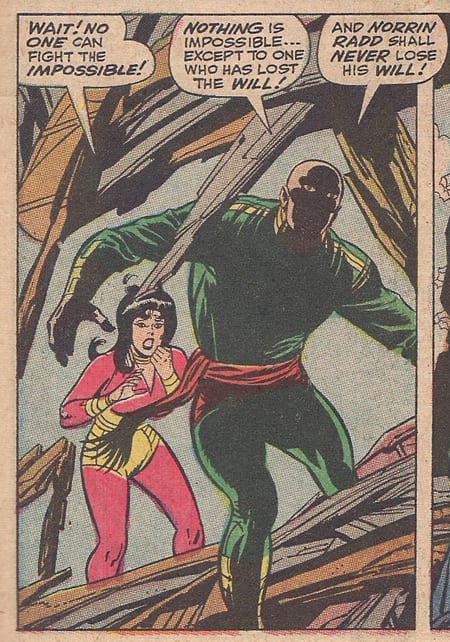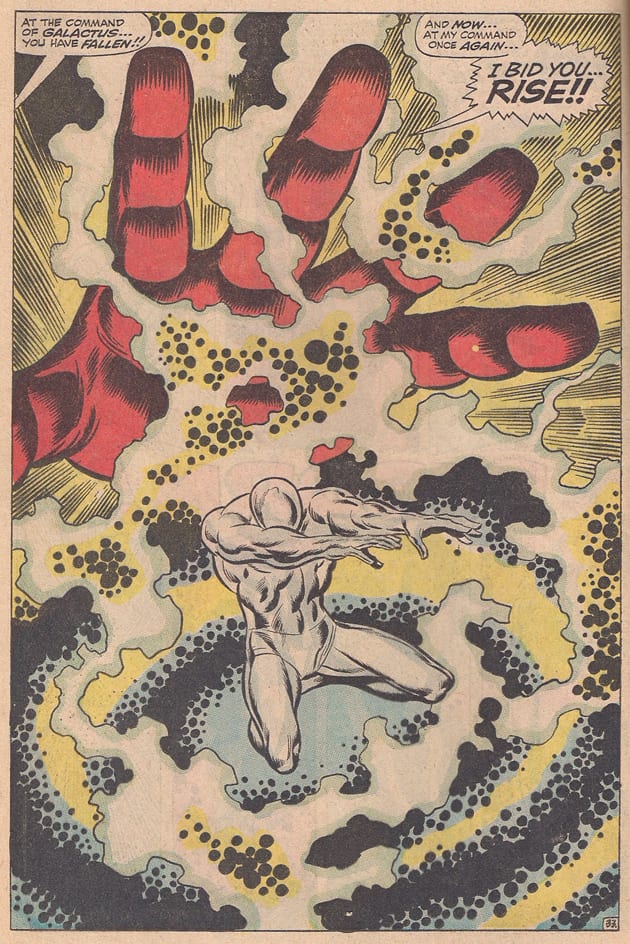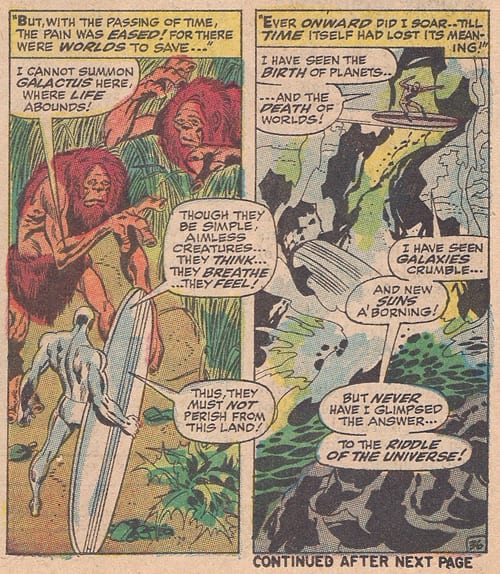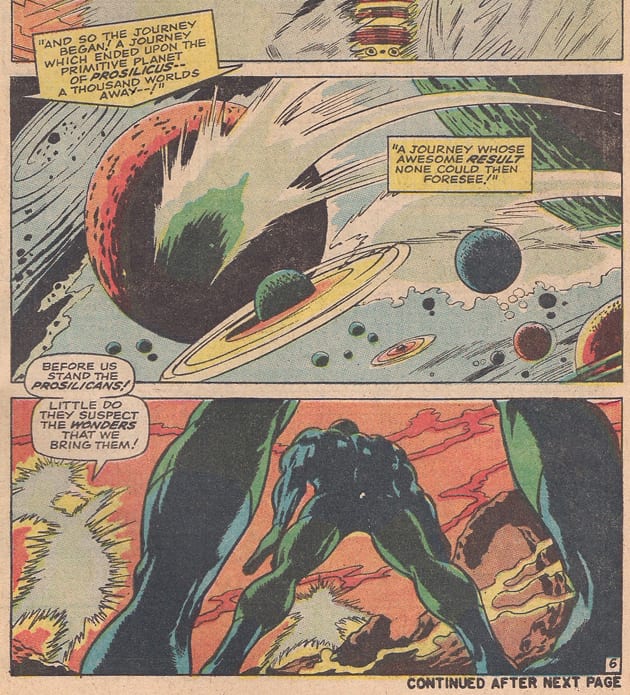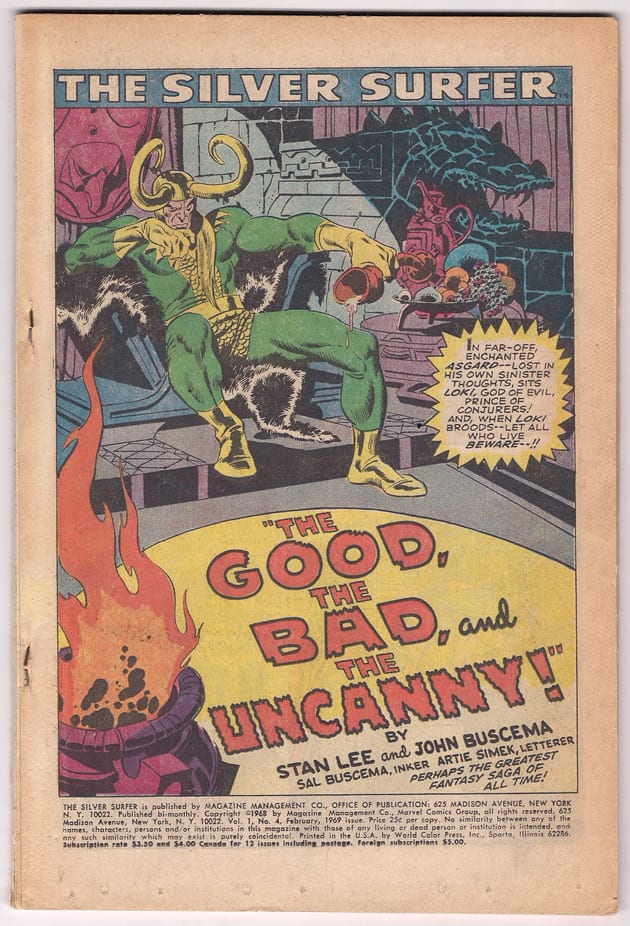"I won't let them take another Silver Surfer away from me." - Jack Kirby.
Silver Surfer #1 is a comic worth examining closely. It has a lot of things colliding at once. It's the straw that broke the camel's back in Jack Kirby and Stan Lee's working relationship. The Silver Surfer series is possibly John Buscema's finest moment. It's Stan Lee's first big self-conscious stab at creating something ambitious and meaningful. It's also a good example of what Lee's writing is like when you subtract Kirby or Ditko from the equation. There are some interesting narrative flourishes, but also a leaden storytelling instinct and deep misunderstanding of his own co-creations.
This isn't the first time I read this comic. It's the second. My copy is coverless and was previously owned by David Hazelwood who signed it. I wasn't about to shell out big bucks for the comic that made Jack Kirby leave Marvel.
The Space Age was already morphing into the Age of Aquarius when "The Origin of the Silver Surfer" made its debut. It starts in the Johnson era with space race imagery. I Dream of Jeanie was in its third season when this comic was written and drawn. With movies like 1967's The Reluctant Astronaut with Don Knotts at the low art end of the spectrum and Kubrick's 2001: A Space Odyssey at the high art end, space capsules and splashdowns were part of the pop culture moment.
Stan pulled out the big guns for this one. With Joe Sinnott on inks, it's the Fantastic Four team, minus the conspicuously absent Jack Kirby.
For John Buscema, this is a star-making moment. He was a rising star at Marvel and would eventually replace Kirby when he abdicates his Marvel throne, taking over Thor and Fantastic Four as his main assignments. He also would eventually fill the Kirby role as the go-to guy for laying out stories for others to finish, basically teaching the next generation how to tell a story in pictures.
His drawings had the dynamism of Kirby, with prettier, leaner figures, and polished traditional draftsmanship. He was a good storyteller, too, with a detailed visual imagination. It was storytelling of a specific Marvel Method type. He was a professional who could fill the gaps in a Stan Lee plot, but for whatever reason lacked the desire or possibly the ability to do a comic solo. He would make one panel lead into the next with rhythm and momentum. He wasn't the creative powerhouse Kirby was, who would create new characters as easily as breathing. He didn't have that inventive spark, but was an excellent interpreter, Metron to Kirby's Himon. He was able to render Kirby's characters and worlds with great conviction. He could compose a convincing scene from any angle, but never filled the balloons. As such we'll probably never know the extent of his storytelling abilities.
It's possible Stan was looking for someone more pliable someone who didn't insist on a point of view the way Kirby or Ditko did, someone who was interested in creating lush beautiful images that tell a story, any story.
The Surfer's body as rendered by John Buscema is leaner, more idealized, more like the body of an actual surfer, with tremendous core strength and balance. A slimmer Surfer than Kirby's graceful yet bulky space gladiator.
Buscema hasn't yet deviated from Kirby's Surfer design in terms of signifiers. No ears, no hair, the neck is thick. There's great torsion on the pose. He's sideways, rather than the straight up and down of the (missing) cover. "One of comicdom's greatest collaborations."
The northern lights spell out "S." The colorist went to town on rendering the logo in silver. If not for the dot screen, I would've thought David Hazelwood did it himself with a blue magic marker. The colorist made up the time lost on the logo by dropping a sheet of yellow and blue on Joe Sinnott's impeccably rendered background.
Stranger in a Strange Land is obviously a touchstone. Can you grok that? Stan Lee is doing his delightfully purple prose thing with "O'er" and "Seeker of truth." The setup in the Fantastic Four comic said that the Surfer was confined to roam the Earth, yearning for the freedom of celestial space and learning what it is to be human. It's a good setup, but it's not set in stone. Why NOT let him roam the universe. Why restrict him? It took until 1987 for that to happen with Marshall Rogers and Steve Engelhart's Silver Surfer relaunch. That was Engelhart's stated purpose, to get the Surfer into space where he belongs.
The late sixties Marvel's Universe (the worlds beyond earth) was not as defined and populated as it is now after decades of post-Star Trek, then post-Star Wars superhero stories. He could meet the Skrulls. He could go to the Blue Area of the Moon. He could go to Asgard (which he does by issue 4), but then what?
The story begins. "The Origin of the Silver Surfer" is a 38-page story, huge compared to the 20 page standard at this time. Already we're getting 4-panel pages, a sure sign of vamping. Unfortunately the extra pages here means there's more space to fill, rather than a broader canvas on which to create a richer story. It's a really nicely drawn comic. Black spotting on the first two panels is complementary. The closeup is nicely rendered. It starts out with the setup of a space age comedy, like I Dream of Jeanie, the return of a space capsule. The sci-fi dialogue (monologue) whiffs of Stranger in a Strange Land and Asimov's Laws of Robotics. I wish these cosmic moments were a little more magical, wondrous and quite frankly black light poster worthy.
Convincing illusion of depth on the beautiful half-splash. ( That's how an original art dealer would describe it to justify a higher price). Nicely executed drawing of Vietnam era aircraft and naval power. This must be in the Gulf of Tonkin. The figure overlaps the panel border. Big area of black on the ocean. This is an engagingly well-crafted page of comics art.
"I saw a guy on a flying surfboard and I said, 'Who's this?' Jack said that Galactus ought to have a herald who flies ahead of him, and I thought it was a wonderful idea. I loved the way Jack drew him, and I thought there was something so noble about him that I'd decided I'd get a lot of philosophy in there, letting him deliver remarks about the condition of life on Earth and how we don't appreciate this Garden of Eden we live in." - Stan Lee
Why did Stan choose to characterize The Silver Surfer like The Hulk and Spider-Man? Was this after someone explained to him that the kids identify with the outsider status of the Marvel characters. The Surfer is misunderstood and hunted. The Marvel formula REALLY feels like a formula here. I understand why they'd react like this to the rampaging monstrous Hulk, or the nerd in a creepy fetish costume, Spider-Man. This makes no sense (no fairy tale sense at least) with the Surfer. He's handsome, divine, otherworldly, luminous, angelic and charismatic -- the same things that attracted Stan to this character the first time Kirby showed it to him, the nobility in Kirby's drawings. He forgot this when it came time to craft a story for the Surfer. He wouldn't be chased, feared and hated. He's too good-looking for that. He'd be revered and worshipped. He'd be a celebrity. I could understand people harassing him looking for miracles, cures and answers to their problems. He'd be overwhelmed by fans. I don't understand why he'd be universally hated and distrusted.
Stan's empty political commentary offends no one and enlightens no one. It's just vague enough to suggest importance while being utterly meaningless. Nothing deep, just topical. Nice tall panel. The coloring approaches psychedelia, but doesn't quite get there.
"Meaningless mouthings of petty pedagogues" if that's how you really feel, lets get rid of all these dialogue balloons.
John Buscema never wrote a comic entirely himself as far as I can tell. I wonder if he wanted to? Ditko and Kirby craved proof of authorship and sought it out by doing projects alone and elsewhere. Silver Surfer #1 is evidence towards the argument that Stan Lee really did view his job as filling the dialogue balloons. If the pictures weren't there it would be poetry. Bad poetry. He just couldn't understand the picture-dominant magic of comics. How flowery are the words? That's his measure of quality. At the time of this comic, the late '60s, songwriters like Harry Nilsson and Brian Wilson were referred to as the new poets, so Stan's approach was appropriately of-the-moment, but there was more '50s Beat poetry coming from the 45-year-old than 60s 'Dylanesque songsmithing. The prior decade's beat poetry is a cultural reference that Stan understood.
Rock 'n roll by this time had become a respectable form of expression among the younger generation. Stan, aware of it or not, was at the center of comics getting there, too. To Stan at the time, poetry is the respected form, not comics, so he makes poetry. When Pop Art was big, he made Pop Art. Anything but comics.
Kirby viewed the Surfer as a rebellious angel, an Old Testament figure. Something out of Byronic epic poetry. Stan viewed him as Jesus. This comic is a few years earlier than Jesus Christ Superstar, but the Jesus Movement was a visible element within the hippie counterculture. Stan wanted his comics to be topical, and Jesus was suitably of-the-moment. Stan Lee, Jack Kirby, and Roy Thomas all did their take on the Jesus story: Roy with Warlock, Jack with Mister Miracle, Stan with Silver Surfer #1. I can imagine the thought process, "We're making a comic about a superhero version of Jesus, what did Jesus do?" Angels did battle with demons. That translates easily enough into comics. What about Jesus? He didn't wrestle lions or slay giants. He gave sermons. He suffered and underwent torture by the government. So that's what the happens to the Surfer, a lot of sermonizing and suffering. It's about as much fun as it sounds. Perhaps if the Surfer found a following to preach to this might've led somewhere, but the Surfer spends this comic preaching to himself.
Buscema draws Silver Surfer's fingers Kirby style for the first and last time. They're blunt and blocky. He's still figuring out what parts of the design to jettison and what to keep.
I cringe at the mention of Norrin Radd or Shalla Bal. Any writer who does a Silver Surfer comic without referencing those names gets an automatic pass from me. It's an unnecessary bit of baggage tacked on to an otherwise elemental character.
The Surfer's design is interesting. Kirby does some of the most ornate character designs and some of the simplest. The Surfer is the starting point of all Kirby's characters. A basic figure with no specific detail (other than genital-covering shorts).
"As though the human race has been divinely favored" This is related to the noxiously popular idea that God put a protective shield around America for being so darned awesome. It's our game to lose. If we step out of line, poof it goes down.
He gives sermons and he suffers. He's Casper the Friendly Ghost all grown up. "Why doesn't anybody like me?"
Finally some actual cosmic art. Buscema hasn't yet mastered the use of Kirby Crackle. It's thrown around arbitrarily. What's that bit of squiggle? Testing out a new pen? Zazzle?
Okay, finally some sci-fi. Why couldn't the Surfer explore a planet like this in the here and now, rather than remebering a planet like this in a flashback?
The Surfer is the first Wolverine, the first Boba Fett, the first Snake Eyes. He was the mystery character with no story of his own, who fans couldn't wait to see more of. The hidden identity makes them reader identification characters. They could be anybody, even you! The more you know about these characters the less you like them. We learn that lesson HARD in this comic. But with these kinds of characters we demand to know. Whether you want to or not, someday the whole story will be told. When it comes time to tell it, it'd better be good.
According to this comic, the 18th one to feature the character, this being made of cosmic energy who didn't even know what food was, started out as a normal dude, a normal dude from another planet, but a dude nonetheless. He's bald. He's got ears and eyeballs, but other than that he's the same as the Surfer but fleshy instead of made of luminous metal. Imagine that with other mystery characters. Okay, Wolverine IS like that, the same sillhouette, the same look with or without the costume, but imagine Boba Fett or Snake Eyes like that.
Lee's Zenn-La is post WW2 America, New York, Manhattan. An urban paradise made possible by the suffering of nomads and warriors of a bygone era. The Surfer is complaining about how great his world is. It's too perfect. Is there anything this guy won't complain about? Isn't this the definition of depression? No matter how good things are you still feel miserable. Peter Parker complains because his life with his domestic partner, his terminally-ill aunt, is indeed a shitty life. This guy complaining because everything's great is something else altogether.
There's an ad in this comic for its companion magazine, Spectacular Spider-Man, another longer, more serious crack at expanding the publishing line. It seems short-sighted for a publisher to have a line of books that MUST connect, and must not have conflicting continuity with other books. Would any other publisher (okay DC) deliberately cripple themselves like that?
"Use of our once-proud limbs affords us no pleasure." As Neil Gaiman famously learned from Karen Berger, there is no masturbation in the DC universe. Apparently that's true in the Marvel Universe, too.
The invention of the conveyor belt, signals the beginning of the end of civilization. This utopia, nicely-drawn and hi-tech, isn't very different than the one in Brave New World, the model for too-perfect futures, from which Stan is cribbing. Is he trying to appeal to suburban teen malaise or are these his real heartfelt musings?
Marvel was more sophisticated and mature than their competition because it's juvenile rather than infantile. Norrin Radd. Is it just random syllables or does it mean something? Norrin sounds weak and dorky, like the go-to MAD name Melvin. Melvin Boguss? ("Boguss" being opposite of "Radd") Radical. Norbert. NoWin? Orrin? If you ask Stan 5 times what the meaning of that name is, he'd give you 5 different answers.
This is a good demonstration of why it's easier to make a comic based on a Norse deity like Thor rather than a Judeo-Christian deity, like the Surfer is modeled on. Lee seems to have forgotten the inherent playfulness of surf culture as a symbol for godhead. (Kirby pushed this absurd dichotomy as far as possible with the grimly absurd Vietnam-Vet-God-of-Death-on-Skis, the Black Racer). The mythology of surfing, as popularized in the documentary Endless Summer is that they are seekers. Of truth? Of fleeting pleasure riding the power of nature?
Lee's other big attempt at making something important, his screenplay "The Monster Maker", as referenced in Spurgeon and Raphael's Stan Lee and the Rise and Fall of the American Comic Book, had similar bromides.
"We deserve no pity for we have done this to ourselves."
"Turning your back on commercialism in order to say something that must be said."
Again, Stan viewed The Surfer as the possible vessel for his artistic legitimacy. For years he didn't let anyone else write the character. His first attempt at an ambitious graphic novel was the Silver Surfer Simon and Schuster book he did with Jack Kirby. Lee refers to Silver Surfer in his treatment for the Silver Surfer movie as "the ultimate honky." Lee's Surfer is bland, bereft of comic book 20th century flamboyance. The character's connection to pop culture is not via comics. It's via surfing , maybe via the pop music of The Beach Boys, who were slightly less threatening than the Beatles, who by this point had shoulder-length hair and beards.
The story goes to a romanticized barbarian past. With barbarian fiction, I wonder to what extent writers believed in it as an actual historical thing. We see muscular cavemen fighting a dinosaur. Then techno barbarians, then illuminated manuscripts. Is Norrin a violent dude who misses the good old days?
The Space Age ended as abruptly as it began. Stan was talking about the age he lived in, but the age Norrin lives in is more like today than like the '60s. Old Norrin and the Surfer both desire space travel, but are trapped by circumstance, though his appearances in Fantastic Four imply that he was born and raised in celestial space, and knows nothing else.
We're back in the present day where he fights a Yeti, who grabs Surfer by the head and throws him around. We are only a few pages into this new comic and already it feels like it's killing time. This is a white character fighting a white opponent against a white background. It's the old joke of drawing a picture of the Invisible Man fighting the abominable snowman in a blizzard.
We're settling into the late '60s Marvel Formula: Wander, Ponder, Fight. Non-super supporting characters are pushed to the periphery. The formula set in motion in Silver Surfer #1 lasted the next 20 years. It lasted until the Jim Shooter era.
Every time you think the story is ready to get rolling, it's revealed as a false start. What this comic really needs is a cast of characters. Stan's avowed dislike of sidekicks is a burden. The Surfer could've used someone to talk to. The Surfer is commenting on situations, but so far hasn't gotten into any situations worth commenting on. A big part of writing is getting your characters into a room together. So far Stan and John haven't been able to get everybody together for actual drama to unfold.
The Surfer is extricated from his supporting cast, the Fantastic Four. We get more flashbacks. Chances are you don't have the other comics, but do readers really need to know about his tussle with the Hulk to understand this story?
Nobody draws villains lounging in a chair like John Buscema. The slouch here is not as grand as the Loki slouch in Silver Surfer #4 or the Mephisto slouch in issue three, but it's quite good.
Here's a recap of the Fantastic Four's finest moment, when Doctor Doom swiped the Surfer's cosmic mojo. There's a slight dutch angle, but otherwise it's a straight cover of the Kirby version. Oddly, the tilt makes the moment a little less momentous. The Kirby version has more force. A gate to somewhere. Might this story finally get started on page 16? This is a double-album bloated prog rock comic. All self-important bluster and virtuosic technical chops, but no heartbeat, no life, no pulse. Stan and John are unwilling to get down and dirty in the real trenches of storytelling.
The closeups are nice. Typically they are an opportunity to get a glimpse of a character's internal life, but this comic is ALL internal life.
Here are some beautiful mythic ruins, but again, they are empty. We spend this comic alone with the Surfer and his sophomoric musings. This scene echoes the empty enterprise of the comic as a whole.
Spinoffs have an inherently sad quality. You take a character away from his friends and family, the familiar surroundings of home. This is Joey with all his Friends gone. This is The Jeffersons leaving their family and neighbors from All in the Family, to live in the hermetically-sealed alienation of a deluxe apartment in the sky, what looks like an old-age home, with only their paid help to keep them company.
"Now all that remains is crumbling rubble-- and the dismal sight of slow decay!" Stan, Marvel, comics, New York, America, civilization. We're watching a one-man show. Silver Surfer is a Spalding Gray-style monologist. Marvel's greatest asset was the large cast of characters to choose from, but here there's no sign of them except in flashback. The house ad for Not Brand Echh shows us the whole gang. The self-parody of NBE is a sign that the Marvel Age as past its prime. Norrin has the same rug from Nick Fury's swinging bachelor pad. "Zenn-La." How come you never mentioned this before, Surfer? "Shalla Bal." So another member of the cast shows up only in flashback. We're 17 pages in to this story, and nothing has happened. The problem with the eternal present of the Marvel Universe is that it forces this story to be told in flashback, robbing it of any immediacy it might've had.
He's a wanderer unhappy at home. Would Norrin have CREATED a planetary disaster if one hadn't presented itself?
3-d printers. The Earth we live in has reached the state of Zenn-La (only a slightly better name than Cobra-La. Adding "La" to the end of a place name is absurd. It doesn't cojure up images of Lost Horizon's hidden city of Shangri-La, but rather Fred Flintstone's Shangri-La-Dee-Da). If Norrin explored his world a little more, he might've found fuel wars and slave mines that sustain his urban paradise. If this truly is a paradise without flaw, without a secret price being paid by an invisible underclass, then Norrin Radd is an asshole.
"Governed by computers" This IS us. "Mine is a lost and lonely voice-- and there are none to listen!" Self-pity ill-becomes an action hero. The Surfer does not say, "I wondered lonely as a cloud," but if he did I wouldn't be surprised. The Silver Surfer Graphic Novel has a similar narrative emptiness to it, at least in the opening retelling of "The Coming of Galactus." Fantastic Four 48-50 with no Fantastic Four means there's no story. No characters to plead Earth's case to the Surfer to bring about his turn away from Galactus. It's too direct.
Has Norrin wished this doom into being with one of Zenn-La's thought-machines? At least issue 1 has the origin to tell. The rest of the series doesn't even have that. It becomes intolerably boring. Kirby knew how to fill up a comic with characters, with purpose. Stan knew how to fill one up with words.
"The computers fail. Employ the weapon supreme." Planets are hurled from orbit like billiard balls. Self-destructed.
Ditkoesque psychedelia. More 4-panel grids means more space-filling.
The eyes look creepy. Ill-placed.
Maybe Stan felt his career was like this. He achieved everything he wanted and it was too easy. Think of Kirby's 26 and 24-page epics for New Gods, bursting with ideas and story, none of the bloat we see here. Kirby still had something to prove. He was trying to build an empire to match the one he made for Marvel.
The 3-d printer makes a ship. Norrin Radd, Last of the Suicidal Zenn-Lads.
The story finally gets interesting as Norrin is humbled before Marvel's God, the Big G. The world is being "ravished" by Galactus. Gross.
Norrin found his perfect companion, someone as verbose and self-pitying as he is. He makes his deal. This is the end of the Surfer's Hero's Journey. His story in Fantastic Four is now rendered moot. The rest of the Silver Surfer series is moot, too, all denouement. Where does your story go when your hero completes his journey in the first issue, in flashback.
This comic was way worse than I remember it being.
We get the awesome, black light worthy art we've been waiting for. As it turns out, the Silver Surfer is not a being of energy. He's just some dude with a silvery glaze.
"I cannot summon Galactus here, where life abounds!" Two panels later the Silver Surfer serves up Earth on a platter to Galactus. If something happened between those two panels that made Surfer suddenly forget the value of life, you probably should've told us about it. That's an important piece of story information, unlike the gratuitous flashbacks that make up the bulk of this 38-page story. Then we get flashbacks to the Surfer's first Fantastic Four appearance. It would've been better to just ignore his previous adventures in Fantastic Four. To remind us of it rubs SS#1's lack of narrative logic in our faces. He's going on a duplicate hero's journey? Learning a lesson he already learned? This makes no sense. Like Alien 3, this comic retroactively diminishes an earlier better work.
In Silver Surfer #4's letter column, Evan Katten addresses the inconsistencies of "The Origin of the Silver Surfer." In the course of the letter he casually, and seemingly unknowingly, justifies each and every one. This is the crowdsourcing of Marvel's mythology that Stan the Editor encouraged in his letter columns and Bullpen Bulletins. Katten gives a chronicle of SS's life thus far and he irons our the paradoxes and narrative lapses. According to the letter writer, between page 36 panel five and page 37 panel one, Galactus's hold on the Surfer has increased so much that he gave him temporary amnesia, which wore off when Galactus removed some of the Surfer's cosmic power after his rebellion at the end of "The Coming of Galactus." The letter is printed without comment.
When I'd read this comic for the first time a year ago, I enjoyed it, until page 37. The way it connects to the Silver Surfer's other appearances is so instantly obviously contradictory, it retroactively kills the character. That naive wanderer I'd been reading about who's learning what it's like to be human. He was human all along. He was just playing dumb. Or suffering from amnesia.
Norrin Radd sacrifices all for Zenn-La. A less charitable way to describe it is a suicidal man decides to kill himself in a way that benefits others. Next he sacrifices himself for Earth. His story is over.
Instead of ignoring this blip, this momentary lapse of logic, it haunts every appearance of this character across all media, the cartoons, the movie all still crowbar references to Norrin Radd, Shalla Bal, Zenn-La. Forget it. Ignore it. Let this character, maybe Kirby's best creation, be what it is and not what Stan Lee spray-painted over it in a moment of blather. There's probably a larger point to be made about sprawling superhero mythologies and the way they stifle storytelling, but that's beyond the scope of this investigation.
It's 38 pages. Two more and it's a Marvel Graphic Novel...and nothing happened. This was Stan's big moment without Kirby, without Ditko and he had nothing to say.
On his Bullpen Bulletin's page, Stan heralds this comic in his famous hyperbolic huckster style, "Silver Surfer #1, featuring the longest, greatest origin tale you've ever read!" "Longest" is right. This comic is filled out by a Watcher tale by Stan Lee and Gene Colan.
This story has convincing space scenes.
Cosmic obliteration. Stan does better with limited space. This Watcher tale says more, looks great and gets more done in its 13 pages than the main story does in its 38. "The Origin of the Silver Surfer" won the 1968 Alley Award for "Best Full-Length Story."
Norrin Radd lives on a perfect world, but is unhappy. That's called depression. This is a depressing comic. I've read depressing comics that I've gotten a lot out of. This is a depressing comic without insight. The most depressing comic of the rapidly tarnishing Silver Age.
This comic is so empty, hollow and depressing that I had to include a better entry in the series, Silver Surfer #4, in my reread to keep things from getting too bleak.
Silver Surfer #4 is certainly closer to Buscema's interests with its Viking halls. Buscema's Hal Foster influence gets to shine. Inked by brother Sal, there are some great panels, nice art, with a broad lively cast.
Silver Surfer #4 is a much better comic, but every bit as narratively empty as Silver Surfer #1. It's better because it leans on the rich cast and setting from Lee and Kirby's Thor comic. It's John Buscema at his very best. Stan yelled at him about what a turd Silver Surfer #4 was, but that was probably a result of his frustration as a writer unable to make anything happen narratively without a writer/cartoonist collaborator like Ditko or Kirby. Stan later, and repeatedly, apologized and reversed his opinion to the extreme, calling Silver Surfer #4 the best comic Marvel ever produced. It's a contender, but only because of a near-superhuman display of virtuosic drawing technique on the part of the Buscema brothers. Personal acrimony with his co-creators probably taints other Lee favorites like "This Man...This Monster." Storywise it's the barest example of the Marvel formula. It also contains Marvel's best black light poster image.
Narratively this scene is slightly more satisfying than similar Surfer sermons in SS#1, because he has an audience to preach to. He has an audience comprised of animals, like another Marvel Comics character, Saint Francis, Brother of the Universe.
Silver Surfer #4 might be Stan's best non-Kirby, non-Ditko comic and it's not without myriad Kirby lifts. Thor's world is Kirby's world. Stan is a verbal embellisher, his role similar to Joe Sinnott: take Kirby and burnish until it gleams. But it's still just a layer of polish over something already great. The Silver Surfer takes a tour through the most visually defined stop in the Marvel Universe. Where do you go from there, when you're out of ideas?
All the false starts to the Silver Surfer #1's story is what Marvel has largely been ever since: self-conscious, overly serious, joyless melodrama, the psychedelic trappings standing in contrast to the bland unstory pantomime.
Reading this comic this closely was a draining experience. I went head-to-head with Stan Lee and he won. I did battle with this comic and came out of the experience scarred and battered.
I met Stan once and at 90 years young he has an overwhelming charisma and energy. Of course Stan in his prime would dance rings around me. You beat me, Silver Surfer #1.
Does it say something about comics that its best-known practitioner doesn't know how to draw? There's a self-consciousness that pollutes modern superhero comics, hell, modern comics in general. We have a much better understanding of the history and potential of comics. Nobody today goes into it by accident. We all want to make great work. When you set out to make a great comic, or rather, an important comic, that's when you clam up.
It's hard to fault anyone for making an empty crappy monthly comic. If by 1968 Stan was burnt out, who could blame him? But Silver Surfer #1 wasn't the result of burnout. This was his attempt at something important, his big statement. This is him doing what he does with full control and full confidence. It is empty as a tomb.
My copy of the comic came apart during this reading of it. Pages cracked and came loose from their staples. Jack has cited the way the Surfer was taken away from him as one of the contributing factors to his leaving the company he'd built up. The Fall of the House of Ideas.



